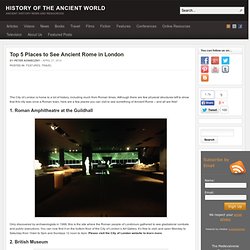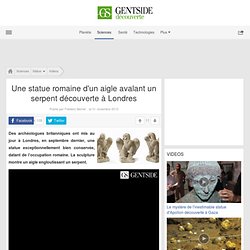

You Can Taste Ancient Greek Recipes in London. 364 41Google +0 0 0 413 A new pop-up restaurant in London is reviving the tastes of ancient Greece.

Stahtis Georgiadis, one of the co-founders of the Philosopher’s Stove, spoke to Kathimerini newspaper. “Given that we cannot re-enact the ancient Greek flavor palette, our project is an attempt to interpret the recipes through today’s contemporary reality, based on our own flavor horizon. We try to be as faithful as possible to recipes and references we come across during our research, always working with the ingredients used back then.
The feedback we get from those tasting our dishes is that the food is tasty, special and kind of off-the-beaten-culinary track,” he said. Georgiadis, who is also a historian, believes contemporary Greeks have maintained some of their ancient ancestors’ eating habits. The Ancient Greek pop up is located at Colney Hatch Lane, N10 London. A Walk Through Roman London. Roman London is still under construction From Spitalfields, you have only to walk down Bishopsgate to find yourself in Londinium, since the line of Bishopsgate St follows that of Ermine St which was the major Roman road north from London Bridge.

Tombs once lined the path as it approached the City, just as they did along the Appian Way in Rome. The essential plan of the City of London was laid out by the Romans when they built their wall around Londinium at the end of the second century, after Boudica and her tribes burnt the settlement. Eighty years earlier, the Romans had constructed a fort where the Barbican stands today and, in their defensive plan, they extended its walls south to the Thames and in an easterly arc that met the river where the Tower of London stands now. Just fifty yards from here at Cooper’s Row, round the back of the Grange City Hotel, is an equally spectacular stretch of wall that is off the tourist trail. By now, it was late afternoon. Roman City Wall at Tower Hill. A Map Of London In Latin. Carte interactive du #Londres archéologique! #archeologie #SIG #London #archaeology. The London Temple of Mithras on Pinterest. Top 5 Places to See Ancient Rome in London.
The City of London is home to a lot of history, including much from Roman times.

Although there are few physical structures left to show that this city was once a Roman town, here are a few places you can visit to see something of Ancient Rome – and all are free! 1. Roman Amphitheatre at the Guildhall Only discovered by archaeologists in 1988, this is the site where the Roman people of Londinium gathered to see gladiatorial combats and public executions. You can now find it on the bottom floor of the City of London’s Art Gallery. 2. The British Museum contains one of the largest collections of artefacts dating back from Roman times, including many found in and around Britain and London. 3. While the Church of All Hallows-by-the-Tower dates from Anglo-Saxon times, a discovery made in 1926 shows this site was also occupied much earlier. 4. 5. Although this site is at times blocked from the public because of construction, the foundation of the Temple of Mithras was discovered in 1954.
Une statue romaine d'un aigle avalant un serpent découverte à Londres. Des archéologues britanniques ont mis au jour à Londres, en septembre dernier, une statue exceptionnellement bien conservée, datant de l’occupation romaine.

La sculpture montre un aigle engloutissant un serpent. Avez-vous déjà partagé cet article? Partager sur Facebook Partager sur Twitter Haute de 65 cm et large de 55 cm, c'est une remarquable pièce qu'ont récemment découverte des archéologues sur le site d’un ancien mausolée découvert à Londres. D'après la description faite, elle représente un aigle tenant dans son bec un serpent - un thème récurrent dans l’art romain - et les plumes de l’oiseau, tout comme la langue fourchue du reptile, sont nettement visibles.
Ceux-ci supposent que la sculpture était placée dans une alcôve de l’ancien mausolée. Un nouvel aperçu "fascinant" Visit Roman London HeritageDaily. Secrets of Underground London: Part 1.